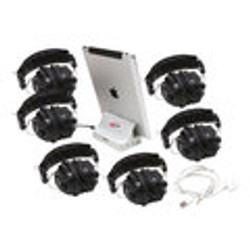5 AV Trends Transforming the Common Core
11th Nov 2014
5 AV Trends Transforming the Common Core
Much of the talk surrounding the Common Core State Standards has been about the content being taught, but few are discussing the audio hardware that districts need to have in place to deliver this content to students.
AV equipment is a small but integral component for successfully implementing the Common Core. Both PARCC and Smarter Balanced assessments require students be provided with headphones, and these pieces of technology also assist educators in delivering instruction.
Evolving technology and instruction demands in the classroom means AV equipment is advancing to meet the needs of today’s schools. Here’s a look at five of the top AV trends for the Common Core in 2014.
Trend: Assessment Requirements
Knowing exactly what type of technology is needed for Common Core assessments isn’t always obvious. Districts are combing through the details outlined in the PARCC and Smarter Balanced * assessments, to learn what students need for testing. Currently, PARCC assessments require headphones be available for all students in the English Language Arts/Literacy testing sessions. Headphones must also be available for students who need them for accommodations (such as text-to-speech) in the mathematics testing sessions.
Smarter Balanced also requires headphones for the English language arts test, and must be provided to students who require text-to-speech features.
 Trend: Passive Listening to Active Response
Trend: Passive Listening to Active Response
Common Core assessments are still in their infancy. As testing begins across the country, more changes are on the way. Recently, PARCC announced that testing during the 2016-2017 school year will integrate oral responses in the Speaking and Listening Assessment section. This mandate marks the transition from passive listening to more active responses. Students will be listening with the earcups, but also actively participating by using a headset’s microphone to give their answers.
Districts need to begin planning now for this transition, and to prepare students for the experience of taking a different type of test.
Trend: Day-to-Day Classroom Activities
The Common Core emphasizes the importance of speech intelligibility, and critical speaking and listening skills in the English language arts (ELA) portion. Headphones and headsets enable educators to incorporate rich audiovisual resources to support these lessons on a daily basis. Headphones and headsets give educators the opportunity to deliver clear instruction directly to their students. This helps students focus and be more engaged with the tasks they are working on. Many headphones and headsets also offer noise reduction features that help limit distractions.
Districts also want students to feel comfortable taking the new Common Core assessments. Using headphones and headsets for day-to-day classroom activities will familiarize students with the experience before testing begins.
Trend: 1:1 Headphone Initiatives
Many districts have already adopted 1:1 technology initiatives for implementing devices such as tablets and laptops in the classroom. However, few have invested in the equipment to fully deliver the learning potential those devices posses to prepare students for the Common Core. Part of being a 21st century school is putting technology into the hands of everyone, and districts are discovering that headphones are an essential piece of this puzzle.
Headphones are crucial for the computer-based programs that are routinely used in the classroom for Common Core lessons, but are only effective if every student has a pair. Districts hoping to make classroom life easier for instructors, and to enhance 1:1 technology initiatives already in place, are working towards providing headphones on a 1:1 basis. The goal is to equip every student with the technology needed to successfully fulfill the Common Core requirements.
Trend: Cost Effective Solutions
District leaders know that keeping up with any trend comes at a price, and funds aren’t always available to make these aspirations a reality. As a result, administrators are seeking cost effective solutions for fulfilling the Common Core listening requirements.
Using ear buds * instead of headphones is an economical way for districts to meet Common Core testing requirements. While, PARCC assessments recommend headphones with a USB connection, ear buds (with a 3.5mm tip ring sleeve) meet the technical specifications outlined. Of course the decision to use ear buds for the short term trades off the health aspects of ambient noise-reducing earcups or a model warranteed to withstand years of classroom use.






